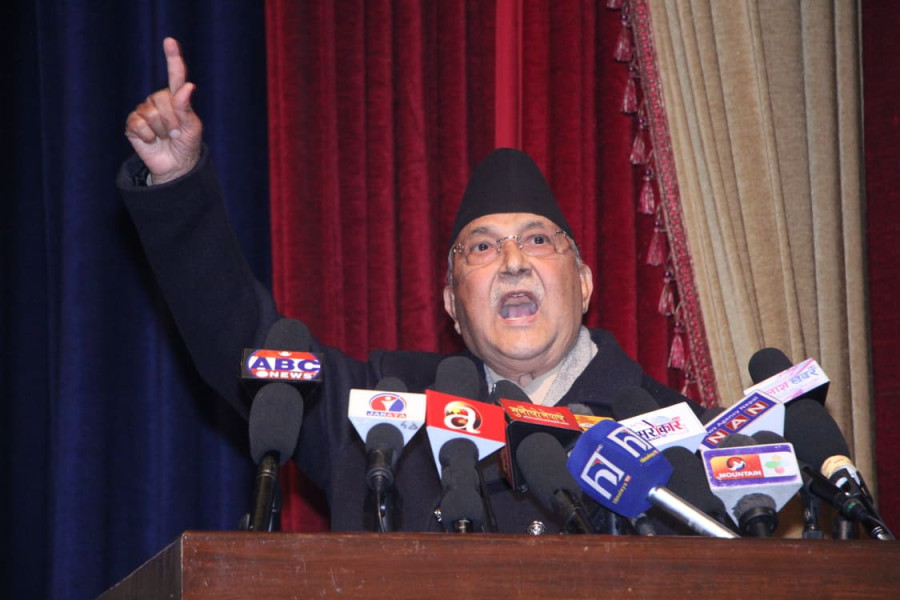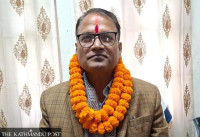National
With a different letter than one sent by the Cabinet, Oli adds to the confusion
While the House dissolution decision signed by the chief secretary does not cite articles, the one undersigned by Oli includes those, thereby creating grounds to suspect foul play.
Tika R Pradhan & Binod Ghimire
The mess Prime Minister KP Sharma Oli has created, it seems, is going to take a while before it is cleared up. After dissolving the House of Representatives and calling snap polls, Oli has thrown the country into political uncertainties, but the way things have surfaced shows he has been bent on creating more chaos.
On Friday, two different letters were leaked to the media—one signed by Prime Minister Oli and the other by Chief Secretary Shanker Das Bairagi.
Both are addressed to the Office of the President regarding the decisions of the Office of the Prime Minister and Council of Ministers on House dissolution and midterm polls.
While the one signed by Bairagi does not say under which articles the House dissolution was recommended, the other signed by Oli cites Articles 76 (1), (7) and Article 85, which the Office of the President too had cited while endorsing the House dissolution move.
During Friday’s hearing on the writ petitions against the House dissolution move, senior advocate Raman Shrestha said that the Cabinet had not cited any articles while recommending the House dissolution.
“How, then, did the President cite Articles 76 (1), 76 (7) and 85?” Shrestha questioned.
It, however, did not take long for another letter to appear in the public domain—this one undersigned by Prime Minister Oli which has cited the articles.
Both the letters are dated Poush 5, 2077 (December 20, 2020), the day the House dissolution decision was recommended to the President.
The letter undersigned by Prime Minister Oli, however, has a seal which says the copy of the Cabinet decision produced for the purpose of the Supreme Court. The seal has the date of Poush 20, 2077 (January 4, 2021).
After the first hearing on December 25 on 13 petitions against the House dissolution, a five-member Constitutional bench led by Chief Justice Cholendra Shumsher Rana had issued a show cause notice and demanded the copies of the Cabinet decision from the defendants—the Office of the Prime Minister and Council of Ministers and the Office of the President.
The Office of the Prime Minister and Council of Ministers and the Office of the President had furnished their original documents to the Supreme Court regarding the House dissolution move, including their clarifications, on January 3.
Oli had argued in his clarification that the House dissolution was a political move and that it did not warrant a judicial review.
However, officials at the Office of the Prime Minister and Council of Ministers had demanded the original letters on January 7, issuing a letter to the Supreme Court promising to return them within January 12 but according to Shrestha they were not given back yet.
Now there are concerns if the recommendation to the President to dissolve the House was drafted later by including the constitutional provisions.
“We have ample grounds to suspect foul play if the documents once presented to the court were taken back,” said Shambhu Thapa, a senior advocate who is pleading on behalf of the writ petitioners. “We were not provided that document earlier.” The recommendation by the Council of Ministers to dissolve the House is also lengthy and long-winded, which too has raised many an eyebrow.
The Council of Ministers has sought to dissolve the House and call snap polls, arguing that the country needed a party to govern with a two-thirds majority so as to accomplish “different activities including the amendment to the constitution”.
“Since political parties too have been demanding an amendment to the constitution time and again and timely amendments have not been possible due to the lack of a two-thirds majority for the ruling party, a majority government is essential,” states the letter undersigned by Prime Minister Oli. “Also to implement the decision to bring back its land included in the country’s map, a two-thirds majority government is needed.”
When Oli returned to power, he commanded nearly a two-thirds majority, as then Rastriya Janata Party and Sanghiya Samajbadi Forum had extended their support to his government. These two parties had agreed to support the Oli government in hopes that their demands for constitutional amendments would be addressed. However, Oli never paid heed to their demands. Given the Nepali Congress’ position, it could have extended support to constitutional amendments as demanded by the Rastriya Janata Party and Sanghiya Samajbadi Forum.
Later in March and December 2019, both the parties withdrew their support to the Oli government.
Many also wonder which particular constitutional amendments Oli is referring to in the letter recommending the House dissolution.
Oli has also stated that he needed a two-thirds majority government to work in favour of the country and the people without hurdles, conclude the peace process and address the nation’s problems effectively. But it is unclear how snap polls can guarantee a majority government in a country which has seen a hung parliament for decades. It’s also unclear what makes Oli so confident that he will get to lead a two-thirds government if elections do happen on the declared dates.
There is nothing much to talk about when the executive head is bent on pushing the country into a crisis, according to Thapa, the senior advocate.
“Everything appears to be a minor issue in a country where the House is dissolved without any constitutional grounds,” Thapa told the Post. “Anything can happen here as people in power are refusing to follow the rule of law.”
Officials at the Supreme Court, however, say the Office of the Prime Minister has not done anything wrong by asking for the letter that it once submitted to the court. There has been a practice of giving such letters back to the Cabinet if a request is made, according to them.
Devendra Dhakal, an information officer at the court, said the government needs the original copy for different purposes and they are handed back whenever asked for.
The court keeps a copy while giving the original document back, Dhakal told the Post.
He, however, refused to explain why the government did not return the documents within the committed time.
Baburam Dahal, a legal adviser to Oli, refused to comment on the matter.
“There is no need for me to comment when everything is before the court,” Dahal told the Post.
But confusion lingers over the content of the two letters—one signed by the chief secretary and the other by Oli.
That the two letters are there and that the original one from the Office of the Prime Minister and Council of Ministers was taken back certainly give grounds for suspicion, according to Bimal Koirala, a former chief secretary.
“It’s the chief secretary who authenticates all the Cabinet decisions,” Koirala told the Post. “There is no need for the prime minister to write different recommendations.”
Tika Dhakal, communication expert to the President, however, disagrees.
“The chief secretary presents the details of all Cabinet decisions to the President while the prime minister makes the necessary recommendations with the constitutional provisions,” said Dhakal. “After the Cabinet took a theoretical decision to recommend that the President dissolve the House, the prime minister made a proper recommendation citing constitutional provisions.”
According to Dhakal, every recommendation must cite constitutional provisions as it is a mandatory procedure.
The Office of the Attorney General, which is taking the lead in defending the Office of the Prime Minister, said there should be no confusion at all as Oli, in his recommendation, has clearly cited the constitutional provisions.
“The recommendation by Prime Minister Oli has cited the needed Articles,” Attorney General Agni Kharel told the Post. “It's the prime minister who has the authority to make the decision of [House] dissolution. The Cabinet’s decision is not [even] necessary.”
But some lawyers who are defending Oli’s House dissolution move agree that the confusion has arisen after the two letters came into the public domain. According to them, things will be clear on Sunday when the Constitutional Bench resumes hearing on the petitions, as the letters will be the first topic of discussion.
“During today’s hearing, senior advocate Raman Shrestha had raised the issue that no articles were cited in Cabinet’s recommendation for dissolving the House. It is a serious matter if true,” said Surendra Bhandari, a senior advocate pleading in favour of Oli’s move. “If Shrestha’s statement is wrong, then also it’s a serious issue.”




 13.12°C Kathmandu
13.12°C Kathmandu
















